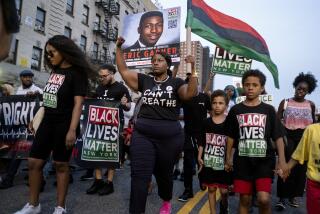Army Casualties Low in Death Rate Study
- Share via
CHICAGO — The peacetime Army is a healthy alternative to civilian life, say military researchers who found that soldiers in 1986 died at half the rate of their civilian counterparts.
But one professor says choosing a year of peace for such a study may obscure the realities of serving a nation that goes to war about once a decade.
Army researchers compared death rates among all 781,000 soldiers to civilian counterparts of the same age, race and sex in 1986.
The study published in today’s Journal of the American Medical Assn. did not give actual death rates. However, the lead researcher said in a telephone interview that soldiers overall died at a rate of 109 per 100,000, while comparable civilians died at a rate of 215 per 100,000.
The greatest disparity was for homicides, almost six times less common among soldiers than civilians, followed by smaller Army rates of deaths caused by disease and suicide, the researchers reported.
The most striking difference was among black men, who died in homicides almost 12 times less often in the Army than in the population at large. The homicide rate among black soldiers was 9 per 100,000, compared with 100 per 100,000 for black civilians, said lead author Joseph M. Rothberg, a mathematician in military psychiatry at Walter Reed Army Institute of Research.
Women in the Army, who make up 10.2% of soldiers, died at 78% the rate of civilian women of the same age. Black women soldiers died at 39% the rate of comparable civilians. But white women soldiers died at 139% the rate of white women civilians of the same age.
A large component of the elevated death rate among white Army women was due to their suffering more than 2 1/2 times as many fatal accidents as civilian women the same age, but the researchers could not say why.
Rothberg said Army volunteers must have high school degrees and be healthy enough to pass a physical exam.
He also said the Army provides housing, food, meaningful work and “lots of fresh air and exercise.” It controls substance abuse and regulates firearms, he said.
Sam Sarkesian, a political science professor at Loyola University in Chicago, said he believed the study could give a skewed picture because it reflects peacetime mortality.
Even in non-war years, members of the military die violently, such as in the 1983 Beirut bombing, when 237 Marines were killed, and in the 1985 Gander, Newfoundland, airplane crash when 248 died.
“From 1945 on, if you’d put all those together and compare it to the equivalent in civilian life, I think you’d get a totally different picture,” Sarkesian said.
But Charles Moskos, a sociology professor at Northwestern University in Evanston, said: “Most of military life is peacetime. A peace year is more normal than a war year.”
More to Read
Sign up for Essential California
The most important California stories and recommendations in your inbox every morning.
You may occasionally receive promotional content from the Los Angeles Times.













